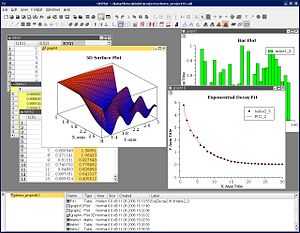QtiPlot
 | |
|
Screenshot of QtiPlot 0.8.5 of 2006 | |
| Original author(s) | Ion Vasilief |
|---|---|
| Stable release | 0.9.8.9 / November 2, 2011 |
| Written in | C++, Python |
| Operating system | Cross-platform |
| Type | Plotting |
| License | GNU GPLv2+ |
| Website |
www |
QtiPlot is a platform-independent cross-platform computer program for interactive scientific graphing and data analysis. It is similar to the proprietary programs Origin or SigmaPlot,[1] and is being used to substitute these in universities.[2]
QtiPlot can be used to present 2D and 3D data and has various data analysis functions like curve fitting. Plotting of 3D data can be rendered using OpenGL using the Qwt3D libraries.
The program is also extensible to a considerable degree via muParser and Python scripting language, which allows adding the arbitrary user-defined functions with access to graphs, matrices and data tables.
Released under the terms of the GNU General Public License (GPL), QtiPlot up to version 0.9.8.9 is free software. Compiled binaries are available for Microsoft Windows, several GNU/Linux distributions and Mac OS X. Downloading binaries from the author's website requires purchase of an annual maintenance contract, however anyone is allowed to compile and distribute binaries under the GPL. This is the case for some Linux distribution repositories[3] as well as for Windows.[4] For recent prereleases (since 2013) no source code is available.
Alternatives
- SciDAVis, forked from QtiPlot in 2007
- LabPlot, another Origin clone
- Fityk, MagicPlot more focused on curve fitting
- peak-o-mat, similar to Fityk
- HippoDraw, focussed on graphing
- Veusz, written in Python
- ParaView, for visualizing huge datasets
References
- ↑ "Review article in LinuxLinks". Linuxlinks.com. 3 April 2011. Retrieved 12 December 2011.
- ↑ "University page about QtiPlot". Omnis.if.ufrj.br. Retrieved 12 December 2011.
- ↑ "QtiPlot packages for Linux". pkgs.org. Retrieved 26 April 2015.
- ↑ "Unofficial QtiPlot Build for Windows". Cells.es. Retrieved 20 November 2014.
